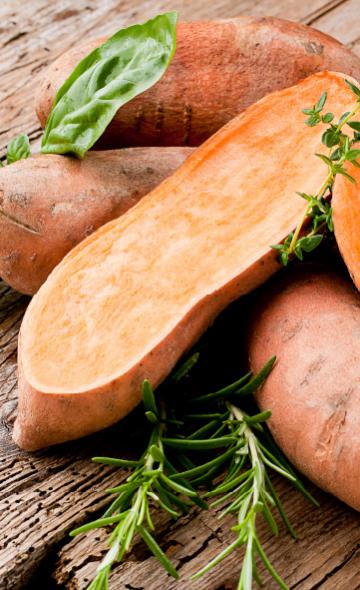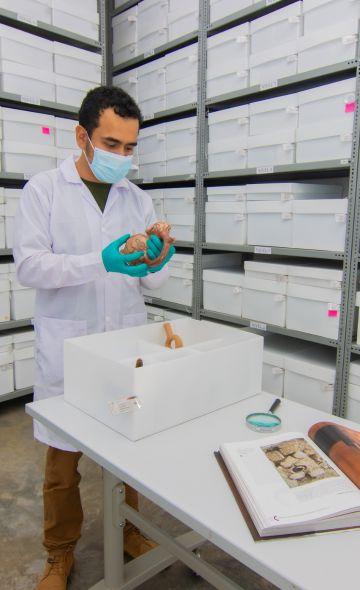- Visitors
- Researchers
- Students
- Community
- Information for the tourist
- Hours and fees
- How to get?
- Virtual tours
- Classic route
- Mystical route
- Specialized route
- Site museum
- Know the town
- Cultural Spaces
- Cao Museum
- Huaca Cao Viejo
- Huaca Prieta
- Huaca Cortada
- Ceremonial Well
- Walls
- Play at home
- Puzzle
- Trivia
- Memorize
- Crosswords
- Alphabet soup
- Crafts
- Pac-Man Moche
- Workshops and Inventory
- Micro-workshops
- Collections inventory
- News
- Community
- Andean Food Series: The Sweet Potato
News
CategoriesSelect the category you want to see:
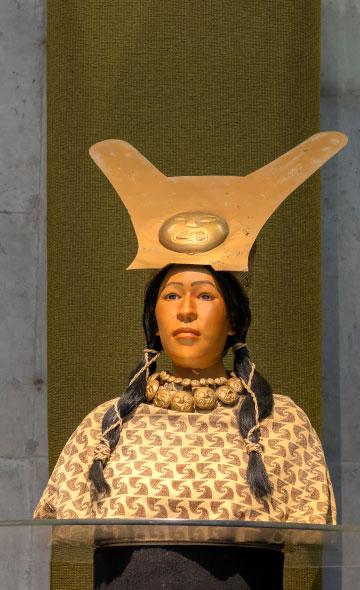
What is an anaco, a garment found in the funerary bundle of the Lady of Cao and in the Lambayeque funerary bundles? ...
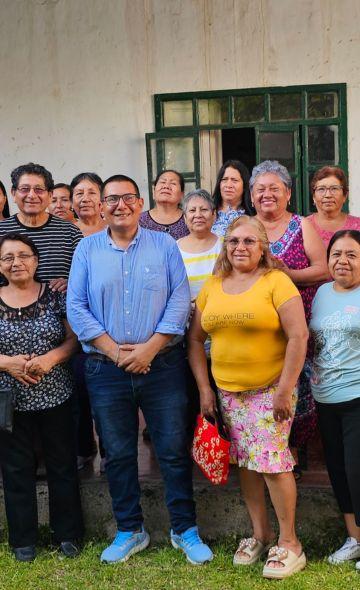
Inauguration of the 2025 Tourism Panel Discussions in Magdalena de Cao ...
To receive new news.
Por: Jose Ismael Alva Ch.
By: Jose Ismael Alva Ch.
Resident Archaeologist of the El Brujo Archaeological Complex
The sweet potato (Ipomoea batatas) is a native tuber of the American continent that currently is the eighth largest agricultural product in the world. Of the 105 million metric tons of sweet potato produced annually on the global level, 80 million come from Asia, with China being the largest producer and consumer (Centro Internacional de la Papa 2015). Let us go over some facts about the history of this sweet tuber, its consumption, and its nutritional properties together.
Domestication and consumption in the Andes
Even though the greatest genetic diversity of sweet potatoes has been reported in Mexico and Mesoamerica, according to recent studies, this tuber was domesticated in the tropical region between southern Central America and northern South America during the Early Holocene (around 10,000 years before the present) (León 2013, p. 88-89).
The oldest remains of sweet potatoes correspond to Phase IV of Huaca Prieta, dating between 5308 and 4107 years before the present (Dillehay 2017, p. 369). Further evidence of sweet potato, recovered from the archaeological site of Caral (in the Supe Valley), as well as in the pre-Hispanic settlements of Huaynuná, Pampa de Llamas-Moxeque, and Tortugas (in the Casma Valley), indicates that the people of the coast had access to domesticated sweet potato during the third millennium BCE (León 2013, p. 91-93).
During the Moche Period (200-800 CE), the presence of sweet potato remains has been documented in the residential spaces of Huaca de la Luna (Vásquez Sánchez & Rosales Tham 2004, p. 362). Furthermore, researchers report representations of the sweet tuber in the ceramics of this northern society (León 2013, p. 94).
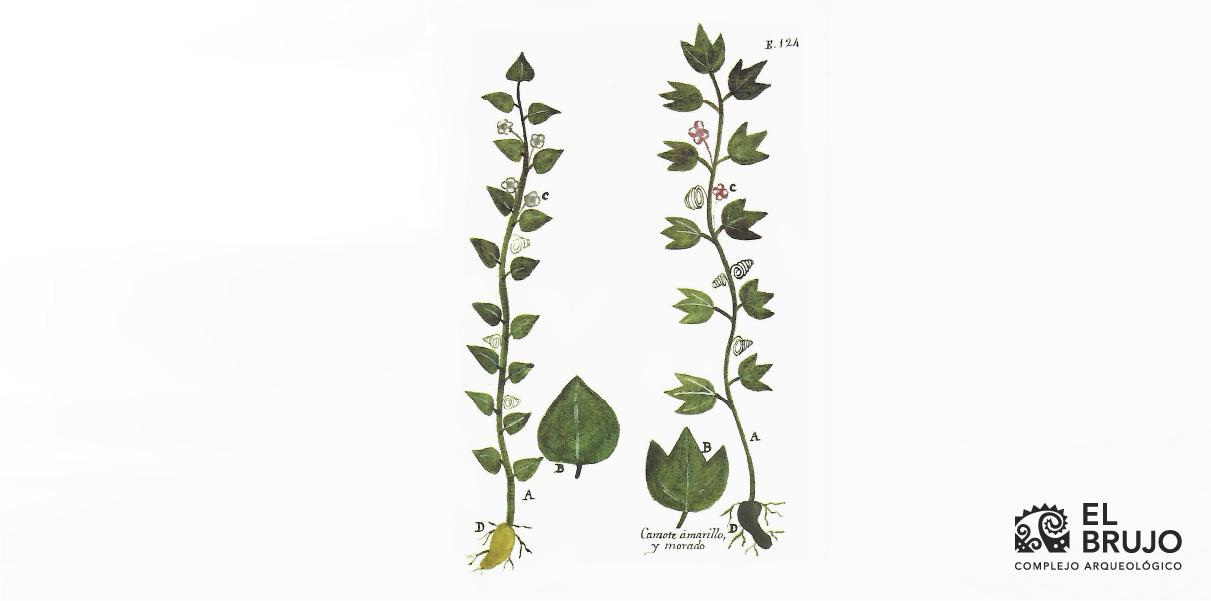 Representation of the yellow and purple sweet potato plants. Drawing from the 18th century published by Bishop Martínez Compañón (Martínez Compañón 1998, f. 124)
Representation of the yellow and purple sweet potato plants. Drawing from the 18th century published by Bishop Martínez Compañón (Martínez Compañón 1998, f. 124)
The ideal side dish for Peruvian gastronomy
The sweet potato is cooked in many different ways in Latin America, where it is consumed habitually depending on the region. In Peru, the sweet potato can be used to replace the potato; however, it also has an important role as a side for traditional dishes. It is boiled for ceviches and escabeches. In pachamanca, sweet potatoes are roasted underground along with the other components of this traditional Andean dish. Also, fried sweet potato is a vital garnish for chicharrones. Furthermore, this sweet tuber is used to make delicious desserts such as puré de camote, picarones, and camotillo.
Regarding the ways of cooking sweet potatoes, boiling is recommended since it results in a smaller loss of proteins and concentration of glucose in comparison to baking (Vidal et al. 2018).

Nutritional value
There are varieties of sweet potato which are expressed through the colors of their skin and flesh. This, consequently, means that their nutritional values can be different. Despite this, experts indicate that this tuber is an important source of carbohydrates, and therefore provides energy to our bodies.
The sweet potato, furthermore, is a source of Vitamin A (in the case of sweet potatoes with orange flesh) and Vitamin C, strong antioxidants that help fight premature aging. Anthocyanin, present in the pulp of purple sweet potatoes, and polyphenols, existing in sweet potato leaves, seem to control the advance of cancerous cells (Centro Internacional de la Papa 2015; Vidal et al. 2018). This tuber is also a source of iron, indispensable in curing anemia and improving physical and mental performance (Vidal et al. 2018). Finally, the sweet potato contains high concentrations of calcium and phosphorous, two minerals that are important for the functioning of our bodies.
References
Centro Internacional de la Papa. (2015). Datos y cifras del camote. https://cipotato.org/es/programas-de-investigacion/camote/datosycifrasdelcamote/
Dillehay, T. D. (Ed.). (2017). Where the Land Meets the Sea. Fourteen Millennia of Human History at Huaca Prieta, Peru. Texas University Press.
León, E. (2013). 14,000 años de alimentación en el Perú. Universidad de San Martín de Porres.
Martínez Compañón, B. (1998). Trujillo del Perú. Agencia Española de Cooperación Internacional.
Reyes, M., Gómez-Sánchez, I., & Espinoza, C. (2017). Tablas peruanas de composición de alimentos. Ministerio de Salud, Instituto Nacional de Salud.
Vásquez Sánchez, V. F., & Rosales Tham, T. (2004). Arqueozoología y arqueobotánica de Huaca de la Luna, 1998-1999. En S. Uceda, E. Mujica, & R. Morales (Eds.), Investigaciones en la Huaca de la Luna 1998-1999 (pp. 337-366). Universidad Nacional de Trujillo.
Vidal, A., Zaucedo-Zuñiga, A., & Ramos-García, M. (2018). Propiedades nutrimentales del camote (Ipomoea batatas L.) y sus beneficios en la salud humana. Revista Iberoamericana de Tecnología Postcosecha, 19(2). http://www.redalyc.org/articulo.oa?id=81357541001
Community , outstanding news


